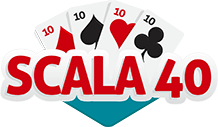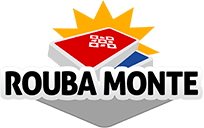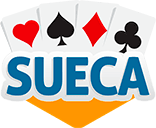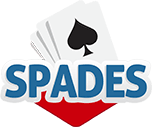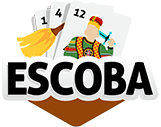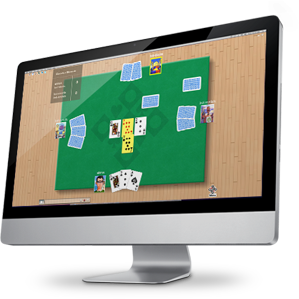 Objective
Objective
Combine a card from your hands with one or more cards on the table to score as many points as you can and reach, before your adversaries, the previously selected score: 11, 16 or 21.
Definitions
Hand = a round given name; multiple hands are played until the defined score is reached.
Escopa = from italian "scopa" (broom) is the action to clean the table, getting all cards to your pile in just one strike; to sinalize the Scopa, you must put a flipped card over the piles. Each Scopa is worth 1 point.
First = The highest card of each suit, that posses a different value from their individual one, defined by a different scoring scale. See the First's table os scores and calculation
7 Belo = the 7 of Diamonds (♦), that is worth 1 point.
Combination = action of playing one of the cards in your hand to draw one or more cards on the table that have the same value of the played card. Example: play a 4 to draw two cards of a value of 2; Play a 3 and drawing an Ace (A=1) and a 2. Check out the cards values for combinations:
| CARD | A | 2 | 3 | 4 | 5 | 6 | 7 | J | Q | K |
| VALUE | 1 | 2 | 3 | 4 | 5 | 6 | 7 | 8 | 9 | 10 |
General Rules
Three cards are distributed for each player and other four cards are placed face-up on the table.
At their own turn, each player must play a card from their hand to draw another(s) from the table and score points. For this to happen, must combine one or more cards on the table to even the one the player used.
When there is a meld (combination), the played card and the table cards go to a pile in front of the player.
When there is no meld (no possible combinations), the played card stays on the table for the next player.
When there is more than one option on the hand or the table (two or more possible combinations) for the played card, it's mandatory to form the combination with the least number of cards.
Example 1
Consider the following hand and table situation for a player:

There are 3 possible combinations:
- Play the 4 from hand and draw the 4 on the table (same value).
TABLE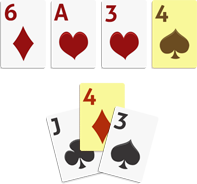
HAND
- Play the 3 from hand and draw the 3 on the table (same value).
TABLE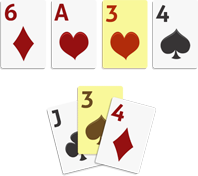
HAND
- Play the Jack (J=8) from hand and draw the cards that, together, sum up to it's value. In this case there is a possible combination if the Jack is played: [ Ace (A = 1) + 3 + 4 ].
TABLE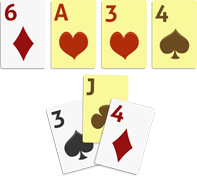
HAND
The final decision about which card the player must play (4, 3 or J), must consider the scoring rules.
Example 2
Consider the following hand and table situation for a player:

Again there are 3 possible options:
- Play the 4 from hand and draw the 4 on the table (same value).
-
Play the 3 from hand and draw the 3 on the table (same value).
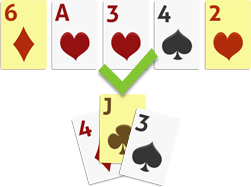
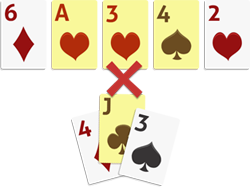
When there is more than one possible combination, the rule is clear: the player must chose the combination with less cards, in this case [ 6 + 2 ].
The final decision about which card the player must play (4, 3 or J), must consider the scoring rules.
When all player's hand cards are over, automatically 3 more cards are distributed each and this repeats until the deck is over.
At the end of each hand the points scoring happens, then , a new hand starts. The first to play is the one sit to the right of the previous starter, and so on.
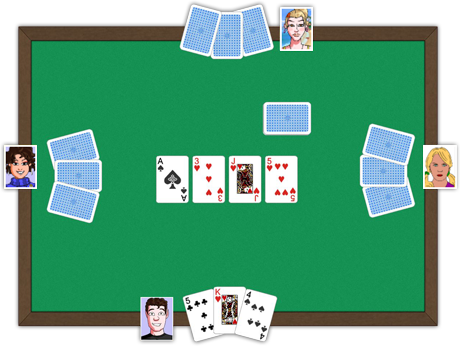
At the end of a hand, if there are still cards left on the table, they
go to the pile of the last player that drew cards, but this clean up is
not worth a Scopa.
Scoring While the individual value of each card indicates which combinations can be done, the player must consider the scoring criteria when it's time to decide which combination he/she will choose.
This is because the maximum score is calculated based in what cards the duo has on their pile at the end of each hand:
| THE DUO THAT HAS: | SCORES | In case of a tie: |
| More cards | 1 point | No one scores |
| More cards from Diamonds suit (♦) | 1 point | No one scores |
| The "First" | 1 point | No one scores |
| The "7 Bello" (7♦) | 1 point | - |
| More Scopas | 1 point each scopa | - |
For the final score, all points from each hand are summed up. Wins the team that reaches first the maximum score choosen at the begining of the match (11, 16 or 21 points).
Understanding the "First"
For calculating the First, you must check the pile of each duo and consider only the highest card from each suit, following the value scale below:
| CARD | 7 | 6 | A | 5 | 4 | 3 | 2 | J | Q | K |
| VALUE | 21 | 18 | 16 | 15 | 14 | 13 | 12 | 10 | 10 | 10 |
The team that has the best result in the sum of those values wins the First, that is worth 1 point at the score.
Example
The "A" duo finishes the game with the following
cards, organized in suits, and with each suits top card placed on the
right side of the others.
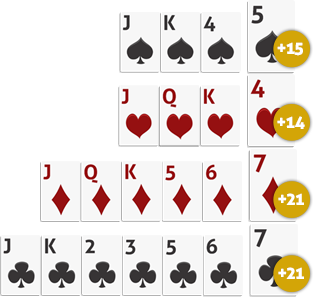
This cards sum up 71 points, according to the First's table of values: card n.5 (=15) + card n.4 (=14) + card n.7 (=21) + card n.7 (=21).
If the "B" duo scored a lower value at the sum of the highest card per suit in their piles, the First's point goes to "A" team.
Tiebreaker Criteria
If the teams score over the score chosen at the beggining in a sigle
hand, wins the duo that has the highest score. In case of a tie, one or
more tiebreak hands are played until there is no more tie.
How to play
Learn how to play Italian Scopa in 10 steps at GameVelvet
1. For starters, choose the game's max score between the table
options: 11, 16, or 21. Important: at Ranked rooms the max score is 16
points.
2. Press F8 key or click at GameVelvet's menu and
select [ CHANGE CARDS ] to play with a numbered deck. After you're used
to Escopa's rules, you can try the original Italian deck and raise your
challenge.
3. Identify who is the one playing at the moment by
the yellow frame around the player's avatar or photo.
4.
Remember, the game flows anti-clockwise. The first player in each hand
is the one just right to the previous starter.
5. Click over
the card that you wish to play and then click over one or all cards from
the table that you wish to draw, being sure that they form a valid
combination. This card will automatically go to a pile in front of you.
6.
If it's not a valid combination, the selected cards won't leave the
table and you'll need to select again.
7. Memorize the value
of each card for hastening your combinations:
| CARD | A | 2 | 3 | 4 | 5 | 6 | 7 | J | Q | K |
| VALUE | 1 | 2 | 3 | 4 | 5 | 6 | 7 | 8 | 9 | 10 |
8. Pay attention for the Diamond suit cards, the 7 Belo card (7 of Diamonds) and to the 6's and 7's of any suit: they have a hiogher value for the First's calculations. If you can, draw them.
9. Memorize all values for the First's calculations. The more high value cards you have at your pile, higher the chances to score the First's point to your final score.
| CARD | 7 | 6 | A | 5 | 4 | 3 | 2 | J | Q | K |
| VALUE | 21 | 18 | 16 | 15 | 14 | 13 | 12 | 10 | 10 | 10 |
10. As soon as you learn how to play Italian Scopa, you'll want to play more and more! Keep on!
In bocca al lupo! Good luck!
Curiosities
History
The game Scopa ("broomstick" in italian) is, up to
today, one of the most popular card game in Italy. The fun is
eternalized in country cities, where italians play games at the parks,
challenging each other and yelling Fatto Scopa! (wiped the table) every
time they do it.
Traditionally, Scopa is played with a Napolitan card deck (from Naples - in italian Napoli, in neapolitan Napule - an iintalian community from the south of Italy, at Campania region, world famous for it's history, music, natural appeal and the land where pizza was invented.
At the Napolitan card deck there are 4 suits: Coppe (Hearts), Ori (Diamonds), Spade (Spades) and Bastoni (Clubs) with values from 1 (Ace) to 7, plus 3 figures: Fante (Jacks, worth 8), Cavallo (Queen, worth 9) and Re (King, worth 10).
The rules are basically the same as Italian Scopa from GameVelvet. And there are more traditional Scopa variants, like the "Asso piglia tutto" (Ace takes all), where tjhe player that plays an Ace draws all cards on the table.
The game is played very often at the italian descendents communities all around the world, being popularized during the 20th century.
Learn how to play other Italian Card Games
Amplify your knowledge at Card Games reading the rules and watching videos from similar games to Scopa .






